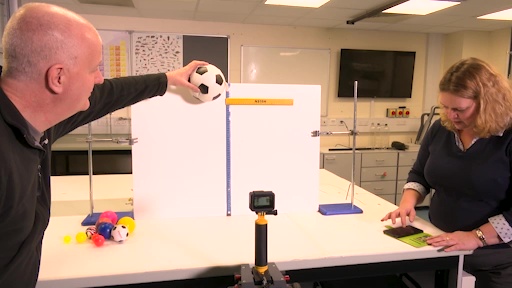3 Practical experiment 3
Practical experiment 3: Investigating gravity
Here you will time objects that fall under gravity to calculate the acceleration of gravity on Earth. This is often called ‘little g’ or g. This terminology is used to distinguish it from Newton’s gravitational constant G, which, unsurprisingly, is called ‘big G’. You met these terms in Section 5 of Week 1. First, watch Video 2.

Transcript: Video 2 Calculating gravity.
Now complete Table 1 using the following guidelines.
- Collect as many objects as you can with different sizes and masses (for example, balls)
- Measure the vertical distance s (in metres, m) from where you are going to drop your object to the ground
- Time the drop t (in seconds, s). Do this for all of your objects.
- Calculate the vertical distance doubled (2 × s).
- Square the time (t2).
- Finally, record your value of the doubled distance (2 × s).
Take care. In the mathematics of motion it is quite common to use the letter s to denote distance. Watch out for also using the same letter as an abbreviation for seconds. When it is used for the unit of time, then it should be an upright symbol, s, if it means distance in an equation it will look like s. That means you have to be especially careful in handwriting!
| Object | Distance s / m | 2 s | Time t / s | t2 | g = 2s / t2 |
|---|---|---|---|---|---|
Table 2 shows the results taken from Video 2.
| Ball | Distance s / m | 2 s | Time t / s | t2 | g = 2s / t2 |
|---|---|---|---|---|---|
| 1 | 0.50 | 1.0 | 0.32 | 0.10 | 9.8 |
| 2 | 0.50 | 1.0 | 0.32 | 0.10 | 9.8 |
The calculations from the results in Table 2 provide a final answer of 9.8 m/s2 for ‘little g’. You met the acceleration due to gravity in Week 1 where the value given was 9.81 m/s2. So this experimental result is quite accurate!
Note that the two values taken from Video 2 are the same (to 2 significant figures). But what if the size of the balls was different? What about their masses? Do these factors affect the final calculations? What if you dropped a feather instead?
To help answer these questions, watch Video 3 which shows a hammer and a feather being dropped at the same time on the Moon’s surface, then complete Activity 3.

Transcript: Video 3 Apollo 15 mission experiment on the Moon.
[BEEP]
[BEEP]
[BEEPING]
[BEEPING]
Activity 3 Effect of air resistance
Choose the correct answers to the following questions.
a.
The hammer and feather arrive on the ground at the same time.
b.
The hammer arrives first.
c.
The feather arrives first.
d.
The hammer’s speed is reduced more than the speed of the feather.
e.
The feather’s speed is greater than the hammer’s speed.
The correct answer is b.
a.
The hammer and feather arrive on the ground at the same time.
b.
The feather arrives first.
c.
The hammer’s speed is reduced more than the feather’s speed.
d.
The feather’s speed is greater than the hammer’s speed.
The correct answer is a.
a.
They are the same.
b.
There is no atmosphere on Earth.
c.
The gravity on the Moon is stronger than the Earth’s gravity.
d.
The Earth’s gravity is weaker than the Moon’s gravity.
e.
There is no atmosphere on the Moon.
The correct answer is e.
You will now look at how planets are formed.
